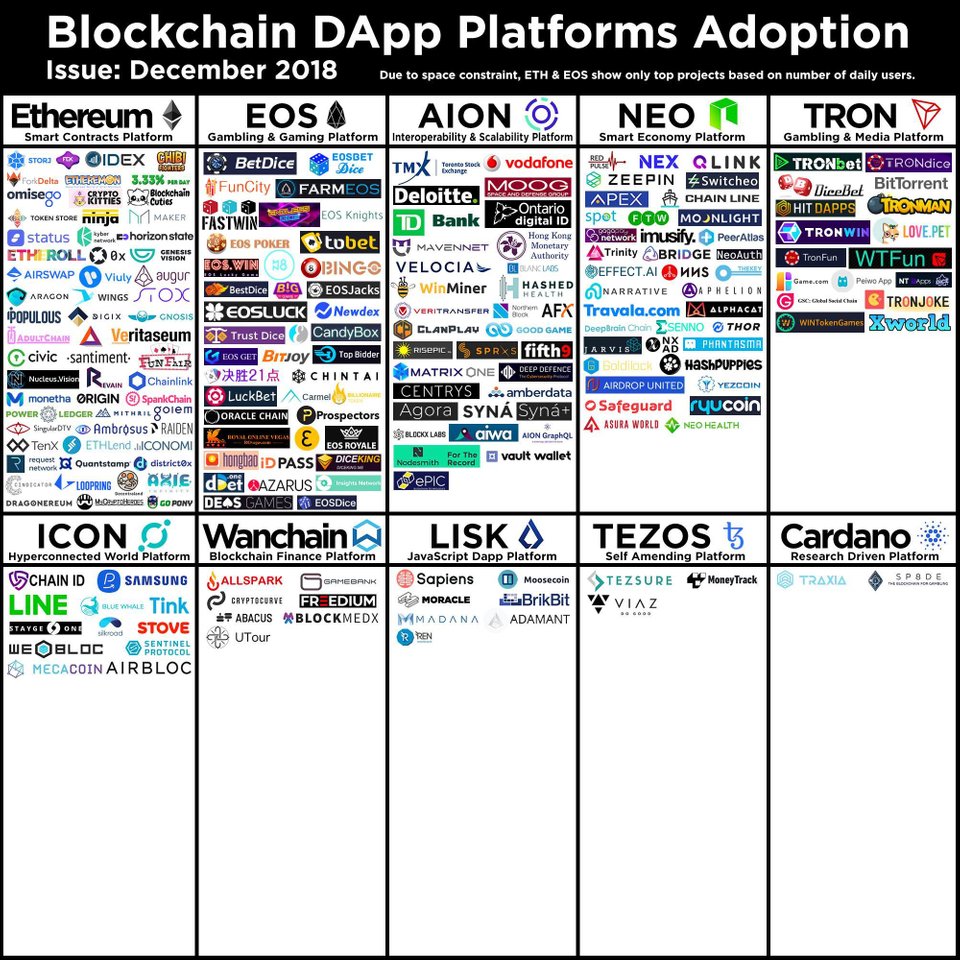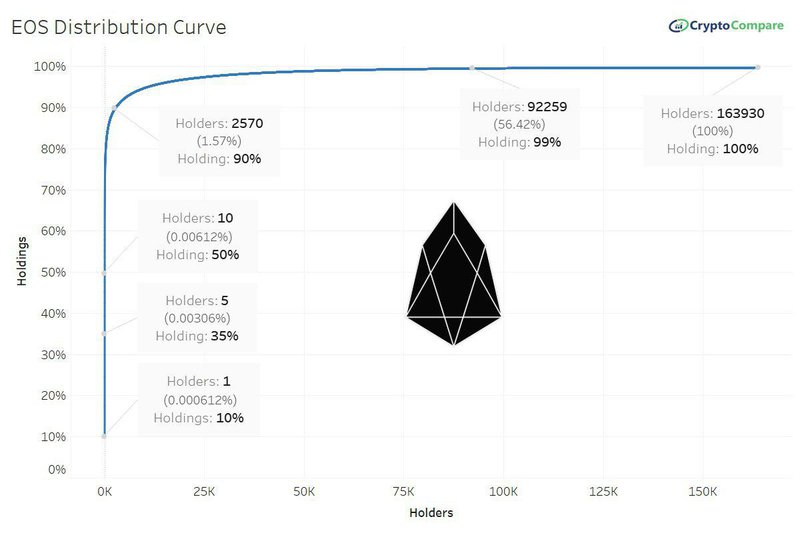The advent of blockchain technology through Bitcoin brought about a different structure for the financial world. It made reliance on third parties and middlemen optional. Other platforms launched with different use cases for blockchain technology, resulting in what is known as decentralized applications, or dapps.
A dapp is an application run by various users (in contrast to just one user), designed to avoid any single point of failure. This means the network on which the applications are run is decentralized so that failure with one source or user will not result in failure of the entire system.
Ethereum, which went live in July 2015, became the first dapp platform on the blockchain ecosystem. Since then, other dapp platforms have joined in, such as EOS, NEO, Qtum, and Tron. Currently, the race is on among these various platforms to see which becomes the most efficient and relevant platform.
The top-performing dapp platforms in the blockchain ecosystem, considering the number of dapps built on them, include Ethereum, EOS, AION, NEO, Tron, Icon, Wanchain, Lisk, Tezos, and Cardano.
The table below shows the number of dapps on each platform, as of December 2018:

The State of Competition Among Blockchain Dapp Platforms
Ethereum
There are over 2,200 dapps currently on the Ethereum blockchain.
According to the website State of the Dapps, there are about 12,000 daily active users of those dapps in over 5,300 contracts. The Ethereum blockchain contains popular dapps such as Storj, IDEX, and Augur. The categories of dapps include games, exchanges, wallet, development, storage, finance, governance, energy, social, property, media, identity, security, and insurance.
Ethereum is currently leading the other platforms in the race for adoption. However, there is the scalability issue that needs to be resolved for the platform to stand strong and maintain the lead.
EOS
EOS launched its platform in 2018 after an ICO that raised over $4 billion.
There were high expectations for the blockchain project from the community. After a shaky start, the platform got its balance and momentum going. As can be seen in the table above, the most popular categories of dapps on EOS include gambling and gaming.
According to State of the Dapps, there are currently 115 dapps on the EOS platform. The number of daily active users recorded is over 41,000, much higher than Ethereum’s 12,000. The dapps with the highest number of users recorded on EOS include Endless Dice, EOS Knights, Candy Box, EOSBET Dice, Dice, and Farm EOS.
The major drawback for the EOS blockchain is the concern that the platform is not really decentralized, and this could discourage some dapp developers from using the platform.
According to research by CryptoGlobe, the top 1.6% of EOS holders own 90% of the token total supply. This can be clearly seen in the graph below:

AION
AION is a blockchain project focusing on interoperability of blockchains. The platform launched in April 2018 and carried out their token swap from September to November 2018.
AION has several partnerships, which are classified as dapps in the blockchain dapp platform adoption chart above. However, most are leveraging the platform for its interoperability feature, since AION functions as a link between blockchains.
Some dapps functional on the AION platform include Mavennet, Velocia, VeriTransfer, and ClanPlay. The major case against AION is whether interoperability will be a strong enough cause for platform adoption.
NEO
There are currently 76 dapps on the NEO blockchain. Popular ones include QLC Chain, NEX, Zeepin, and Red Pulse. The top categories of dapps on the NEO blockchain include exchange, marketplace, media, service, gaming, and identification.
NEO Economy highlights 40 active tokens on NEO and their 30 days usage chart. NEO has recorded transaction speed of up to 2433tps, but the current speed is below 400tps.
Although the blockchain platform is currently faster than Ethereum, it has suffered several downtimes, even though it has far fewer dapps than Ethereum.
TRON
TRON currently has 49 dapps on its platform, according to dappradar.
Most of the functional dapps are in the gambling category. The top ones include TronDice, TronBet, Fishing Master, and DiceBet. The only dapp among the top dapps not in the gambling category is GOC DEX (which is in the exchange category).
The top 3 dapps on TRON have an average of about 285,000 transactions in 24 hours. The top 3 dapps on Ethereum manage an average of about 2,800 transactions in 24 hours.
The challenge for TRON, however, is whether it can be able to replicate its adoption success in the gambling category with other categories.
Other Dapp Platforms
There are currently 10 dapps on the ICON platform: Blue Whale, WeBloc, Cosmochain, Airbloc, MECA Casino, Carboneum, ZenSports,
Discover X, LogisticsX, and Stayge. All other projects listed under ICON on the blockchain dapp platform adoption chart are partnerships which could possibly create dapps on the platform in the future.
Wanchain is an interoperable blockchain that is also a dapp platform. A number of dapps are currently being built on Wanchain, some of which are Abacus, Freedium, and AllSpark.
Lisk is a blockchain platform that enables programming dapps in JavaScript. Some dapps on Lisk include Madana, Rencoin, Sapiens and Brikbit.
Tezos launched its mainnet in September 2018. The dapps currently on the platform include Tezsure, Viaz, and MoneyTrack.
Finally, there is Cardano, which has just released new tools for writing smart contracts. The dapps currently on Cardano are Traxia and Sp8de.
Conclusion
The competition for mainstream adoption between the blockchain platforms has just begun to heat up. Ethereum still appears to be in the lead, but the gap is getting narrower.
The gambling and gaming category seems to be the top category of dapps according to number of dapps (correlating with a number of users) across all the current blockchain platforms. Other top categories include exchange, finance, and storage.
While EOS and TRON currently capture a significant bulk of gambling and gaming dapps, most functional dapps in other categories are on Ethereum.
This speaks well of Ethereum as being the platform that really captures the full potential of smart contract technology over a wide range of sectors. However, it can also be interpreted as being in favor of EOS and TRoN, as their speedy on-boarding processes which have attracted gaming and gambling dapps can easily be replicated for other categories when the time comes.
Going into 2019, Ethereum is focused on resolving the scalability issues of the platform. EOS seems to be more focused on creating a vibrant ecosystem that can compete with Ethereum. TRON, on the other hand, is focused on luring developers (especially from other platforms) and creating more use cases for the TRX cryptocurrency.
2019 will be a competitive year for blockchain platforms, as this is the first time that Ethereum will begin the year with more and serious contenders. There are several other developments to watch in the crypto space, and all in all it should be an exciting year ahead of us.

